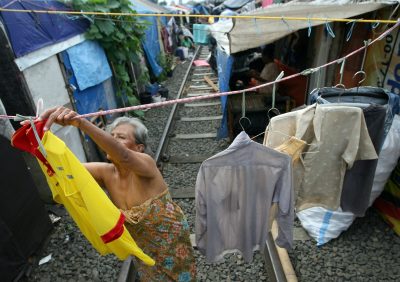
Along with the rates of economic growth, inflation and employment, and other economic and social indicators, income elasticity of poverty should be regularly monitored to see how well poverty reduction programs are working and what more can be done.
Development researchers cover many dimensions when discussing poverty in developing countries. Numerous studies have focused on the size of the response of the poverty rate to growth of real per capita income, usually stated in terms of income or growth elasticity of poverty. But almost all these studies consider the global or regional magnitude of the elasticity, overlooking cross-country variations in the response of poverty to income growth.
There are large differences between countries in their income elasticity of poverty. This is often measured as the percentage reduction in purchasing power parity $1.25 poverty headcount (that is, the proportion of people living below the $1.25 poverty line) associated with a 1 per cent annual rate of real GDP per capita growth. For example, during the period 1990–2005, India’s income elasticity of $1.25 poverty was 0.35, while Pakistan’s elasticity was 4.67.
Although the calculations should not be taken literally, this implies that an annual increase of 13 per cent in India’s real GDP per capita would have generated the same rate of reduction in the poverty headcount as a 1 per cent annual real GDP per capita growth in Pakistan. Similarly, it would have taken a nearly 6 per cent annual increase in real GDP per capita in Vietnam (with an elasticity of 0.47) to achieve the same rate of poverty headcount reduction as a 1 per cent annual increase in real GDP per capita in Indonesia (which had an elasticity of 2.81) during 1990–2005.
Many factors — particularly governments’ economic and social policies — are responsible for these large differences between countries. Taking note of these differences, policymakers, development scholars and international organisations can explore the country-specific underlying factors and identify lessons for poverty reduction. But there are some general approaches that might enhance the response of poverty to increased income, raise the size of the income elasticity of poverty and accelerate the pace of poverty reduction.
Appropriate redistributive policies can obviously increase the pace of poverty reduction and raise the response of poverty to income growth. But the World Bank’s recent policy agenda focuses on ‘growth with equity’. It includes several measures that the governments of developing countries can consider to enable the poorest to fully participate in and benefit from the growth process. Besides sustaining broad-based and ‘inclusive’ growth, these measures include investing in human development through education, health programs, safe water and sanitation, as well as protecting the extremely poor from destitution and associated risks. If national governments earnestly consider such measures, the response of poverty to increasing income may rise.
The World Bank currently focuses on growth of income of the bottom 40 per cent, as opposed to the previous practice of looking mainly at the overall rate of income growth. This should also help improve the response of poverty to increased income. A recent report of the Bank indicated that increased labour incomes have been an important factor in poverty reduction. If governments adopt measures to enhance labour income — especially through public employment programs in poor areas — the extent to which growth helps to reduce poverty should increase.
The inclusion of poverty reduction, along with economic growth and related measures, in discussions among policymakers, development scholars and civil society should also enhance the response of poverty to income growth. The discourse in many developing countries is still dominated by economic growth and the various measures associated with it. Little consideration is given to the impact of these measures on poverty reduction — which is often relegated to a secondary concern. The implicit assumption is that growth is what matters; poverty reduction will follow at some ‘natural’ rate.
My simple estimates of income elasticities of $1.25 poverty for 1990–2005 indicate large cross-country variations in the response of poverty to income growth, suggesting that there is probably no such ‘natural’ rate. Economic growth can translate into poverty reduction at widely different rates. Some governments, but not all, have apparently adopted measures to increase the rate at which economic growth translates into poverty reduction. As such, policymakers, researchers and international organisations should drop the implicit assumption that there is some ‘natural’ rate at which income growth automatically translates into poverty reduction.
Irrespective of how it is measured, income elasticity of poverty should be regarded as an important indicator of the success of a developing country government’s poverty programs and in using economic growth to further poverty reduction. It should be treated as a simple measure of the extent to which growth is ‘pro-poor’, broad-based or ‘inclusive’.
While there are many other measures of pro-poor growth, income elasticity is particularly simple, direct and easy to construct. Like the rates of economic growth, inflation and employment, and other economic and social indicators, income elasticity of poverty should be regularly monitored to see how well poverty reduction programs are working and what more can be done. Most developing countries consider economic growth and poverty reduction in a somewhat disjointed manner; income elasticity of poverty provides a useful link.
This article has been republished from eastasiaforum.org.